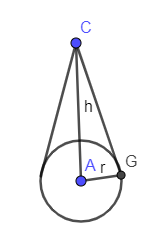
The CSA of a cone is $4070c{{m}^{2}}$ and its diameter is 70cm. What is the slant height?
Answer
504.3k+ views
Hint: We have given CSA (Curved Surface Area) of the cone which is equal to $4070c{{m}^{2}}$. Also, we have given the diameter of the cone. We know the relation between diameter and radius which is equal to $d=2r$ where “d” is the diameter and “r” is the radius of the cone. We know the formula for CSA of the cone which is equal to $\pi rl$ where “r” is the radius of the cone and “l” is the slant height of the cone. Equating this formula to $4070c{{m}^{2}}$ and then from this equation we will get the slant height of the cone.
Complete step by step answer:
In the above problem, the CSA of the cone is given as:
$4070c{{m}^{2}}$
Also, the diameter of the cone is given as:
70cm
We know the relation between the diameter and the radius of the cone as:
$d=2r$
Where “d” is the diameter and “r” is the radius of the cone.
Substituting the value of “d” as 70cm in the above equation we get,
$\begin{align}
& 70cm=2r \\
& \Rightarrow r=\dfrac{70}{2}cm \\
\end{align}$
From this equation, we can find the value of radius using the diameter.
In the below figure, we have drawn the diagram of the cone.

In the above figure, we have shown slant height by CG (let’s call it “l”).
We know the formula for the CSA of the cone which is given as follows:
$\pi rl$
In the above formula, “r” is the radius of the cone, and “l” is the slant height of the cone. Now, equating the above surface area to $4070c{{m}^{2}}$ we get,
$\pi rl=4070c{{m}^{2}}$
Substituting the value of “r” and $\pi =\dfrac{22}{7}$ in the above equation we get,
$\dfrac{22}{7}\left( \dfrac{70cm}{2} \right)l=4070c{{m}^{2}}$
In the above equation, 7 and 2 will get canceled out from the numerator and the denominator on the R.H.S of the above equation we get,
$\dfrac{11}{1}\left( 10cm \right)\left( l \right)=4070c{{m}^{2}}$
One zero and one “cm” will get canceled out from both the sides of the above equation we get,
$11\left( l \right)=407cm$
Now, dividing 11 on both the sides of the equation we get,
$l=\dfrac{407}{11}cm=37cm$
From the above, we got the value of “l” as 37 cm. Hence, we have calculated the slant height of the cone as 37 cm.
Note: To solve the above problem, you need to know the relation between diameter and radius. Also, you must know the formula for the CSA of the cone. The mistake which often occurs in this problem is that you might forget to convert the diameter into radius so make sure you won’t make this mistake.
Complete step by step answer:
In the above problem, the CSA of the cone is given as:
$4070c{{m}^{2}}$
Also, the diameter of the cone is given as:
70cm
We know the relation between the diameter and the radius of the cone as:
$d=2r$
Where “d” is the diameter and “r” is the radius of the cone.
Substituting the value of “d” as 70cm in the above equation we get,
$\begin{align}
& 70cm=2r \\
& \Rightarrow r=\dfrac{70}{2}cm \\
\end{align}$
From this equation, we can find the value of radius using the diameter.
In the below figure, we have drawn the diagram of the cone.

In the above figure, we have shown slant height by CG (let’s call it “l”).
We know the formula for the CSA of the cone which is given as follows:
$\pi rl$
In the above formula, “r” is the radius of the cone, and “l” is the slant height of the cone. Now, equating the above surface area to $4070c{{m}^{2}}$ we get,
$\pi rl=4070c{{m}^{2}}$
Substituting the value of “r” and $\pi =\dfrac{22}{7}$ in the above equation we get,
$\dfrac{22}{7}\left( \dfrac{70cm}{2} \right)l=4070c{{m}^{2}}$
In the above equation, 7 and 2 will get canceled out from the numerator and the denominator on the R.H.S of the above equation we get,
$\dfrac{11}{1}\left( 10cm \right)\left( l \right)=4070c{{m}^{2}}$
One zero and one “cm” will get canceled out from both the sides of the above equation we get,
$11\left( l \right)=407cm$
Now, dividing 11 on both the sides of the equation we get,
$l=\dfrac{407}{11}cm=37cm$
From the above, we got the value of “l” as 37 cm. Hence, we have calculated the slant height of the cone as 37 cm.
Note: To solve the above problem, you need to know the relation between diameter and radius. Also, you must know the formula for the CSA of the cone. The mistake which often occurs in this problem is that you might forget to convert the diameter into radius so make sure you won’t make this mistake.
Recently Updated Pages
Two men on either side of the cliff 90m height observe class 10 maths CBSE

What happens to glucose which enters nephron along class 10 biology CBSE

Cutting of the Chinese melon means A The business and class 10 social science CBSE

Write a dialogue with at least ten utterances between class 10 english CBSE

Show an aquatic food chain using the following organisms class 10 biology CBSE

A circle is inscribed in an equilateral triangle and class 10 maths CBSE

Trending doubts
Which of the following does not have a fundamental class 10 physics CBSE

What is the full form of POSCO class 10 social science CBSE

State BPT theorem and prove it class 10 maths CBSE

A Gulab jamun contains sugar syrup up to about 30 of class 10 maths CBSE

Write the difference between soap and detergent class 10 chemistry CBSE

A triangle ABC is drawn to circumscribe a circle of class 10 maths CBSE




